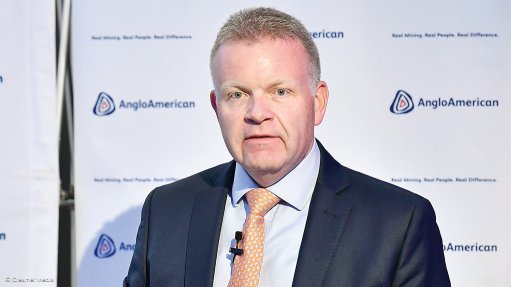Sibanye-Stillwater commits additional R30m to Wits Digimine
Sibanye-Stillwater has committed an additional R30-million over three years, to the University of the Witwatersrand (Wits) Mining Institute’s Digital Mining Laboratory (Digimine). The company ring fenced the funding to invest in safety related technologies as part of a stream financing arrangement in 2018.
The announcement was made on Monday, at the Wits Chamber of Mines building, during a two-day seminar hosted by the Wits Mining Institute (WMI).
Sibanye has already invested R17.5-million into the Digimine, with a further R10-million committed for 2019 and 2020.
During his keynote address, Sibanye technology and innovation unit manager Alex Fenn explained that the funding would be used to fast-track technologies and prototypes initiated by the WMI, in partnership with the Wits Siemens Solutions Laboratory; as well as mine seismicity research, to enhance the sustainability of the WMI and the Digimine, enhance the delivery structure of the research and development agenda and create the Sibanye Health and Safety DNA project.
WMI head Professor Fred Cawood explained that the Wits Siemens Solutions Laboratory is set up to assist in bridging the gap between the outcomes of applied research and the commercialisation of prototypes for use in the broader mining industry.
It also seeks to assist students and members of the public who do not necessarily have a mining background or qualification, but have an idea or invention that can further the field. The laboratory enables innovators to meet with technology companies and researchers to evaluate the potential of commercialising their innovations.
Fenn relayed a comment from Sibanye CEO Neal Froneman that “this commitment represents Sibanye’s recognition of the criticality of fundamental and applied research, bridging the gap between research and commercialisation, as well as talent and educational development to its technology and innovation strategy.
“We look forward to the outcomes of the programme as key enablers of our vision of superior value creation for all of our stakeholders through responsible mining and beneficiation of our mineral resources.”
Fenn ran through several examples of where digital technologies had improved yields, profitability or sustainability of existing mines, including Chelopech, a fully digital gold mine in Bulgaria, whose digital transformation strategy was a key enabler to improving by 142% and reduce its costs by 48%, in the eight years after embarking on its digital strategy.
He added that Sibanye has a portfolio of projects as part of its technology and innovation strategy, which, if implemented could result in an increase in Sibanye’s earnings before interest, taxes, depreciation and amortisation of between 57% and 79%, in the long term.
Fenn also reported on the company’s work to reduce rail-bound equipment (RBE) fatalities and injuries. He explained that the company, having all but eliminated RBE fatalities by implementing a new safety system in 2012, noted a continuous regression of non-fatal injuries in the same period.
“We were a little complacent in the sense that we had good track record with respect to fatalities in that space . . . but our general safety trends indicated otherwise . . . so we used data more effectively and did an in-depth analysis on every accident over the past few years, highlighting areas of concern.”
He explained that the research found that five areas were responsible for 69% of all RBE incidents and used that information to fix those parts of the value chain.
“We’ve seen a 55% reduction in RBE incidents, purely by using information that we already had a little better than before. This is a clear demonstration of the value of data in all areas of the mining value chain.”
Comments
Press Office
Announcements
What's On
Subscribe to improve your user experience...
Option 1 (equivalent of R125 a month):
Receive a weekly copy of Creamer Media's Engineering News & Mining Weekly magazine
(print copy for those in South Africa and e-magazine for those outside of South Africa)
Receive daily email newsletters
Access to full search results
Access archive of magazine back copies
Access to Projects in Progress
Access to ONE Research Report of your choice in PDF format
Option 2 (equivalent of R375 a month):
All benefits from Option 1
PLUS
Access to Creamer Media's Research Channel Africa for ALL Research Reports, in PDF format, on various industrial and mining sectors
including Electricity; Water; Energy Transition; Hydrogen; Roads, Rail and Ports; Coal; Gold; Platinum; Battery Metals; etc.
Already a subscriber?
Forgotten your password?
Receive weekly copy of Creamer Media's Engineering News & Mining Weekly magazine (print copy for those in South Africa and e-magazine for those outside of South Africa)
➕
Recieve daily email newsletters
➕
Access to full search results
➕
Access archive of magazine back copies
➕
Access to Projects in Progress
➕
Access to ONE Research Report of your choice in PDF format
RESEARCH CHANNEL AFRICA
R4500 (equivalent of R375 a month)
SUBSCRIBEAll benefits from Option 1
➕
Access to Creamer Media's Research Channel Africa for ALL Research Reports on various industrial and mining sectors, in PDF format, including on:
Electricity
➕
Water
➕
Energy Transition
➕
Hydrogen
➕
Roads, Rail and Ports
➕
Coal
➕
Gold
➕
Platinum
➕
Battery Metals
➕
etc.
Receive all benefits from Option 1 or Option 2 delivered to numerous people at your company
➕
Multiple User names and Passwords for simultaneous log-ins
➕
Intranet integration access to all in your organisation


















